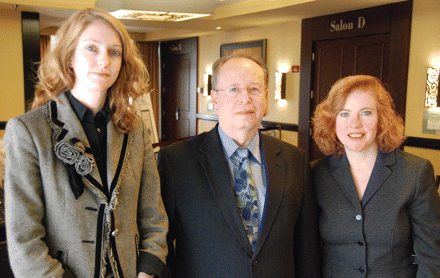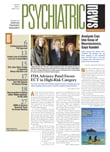A Food and Drug Administration (FDA) advisory panel rendered mixed opinions on whether the devices used for electroconvulsive therapy (ECT) should be placed in a moderate-risk category with other noninvasive equipment or remain in the highest-risk class, requiring the kind of extensive—and expensive—new research demanded of newly marketed products.
In a series of nonbinding votes after a two-day hearing in January, majorities of the panelists preferred keeping ECT devices in the more restrictive Class III when used for major depression, schizophrenia, bipolar disorder, schizoaffective disorder, and schizophreniform disorder. They favored a Class II designation for use with catatonia, citing a lack of other useful treatments.
The Neurological Devices Advisory Panel's views will help the FDA decide whether to reclassify the equipment from Class III to Class II with special conditions for use attached. For the moment, however, nothing has changed in the availability or use of ECT.
Along with 100 other devices, ECT equipment was grandfathered into Class III as a temporary step without further clinical trials after passage of the Medical Device Amendments of 1976.
In the years since, the FDA has evaluated 74 of those devices and assigned them to final status into Class I, II, or III under section 510(k) of its regulations. The agency began in 2009 to decide on where to place the last 26 devices on the list, including those used in ECT.
Class III includes high-risk medical devices that are critical to sustain life (such as implantable pacemakers) or that present "a potential unreasonable risk of illness or injury." They ordinarily require premarket scientific trials and FDA approval to ensure safety and effectiveness.
Moderate risk, Class II devices (equipment like X-ray machines or wheelchairs) don't require such evidence but are subject to additional controls such as special labeling requirements, mandatory performance standards, and postmarket surveillance.
The two small U.S. companies that manufacture ECT machines have said that clinical trials typically required for Class III devices would be prohibitively expensive and might lead to withdrawal of the devices from the market.
William Narrow, M.D., M.P.H., associate director of APA's Division of Research and the American Psychiatric Institute for Research and Education, presented APA's views to the panel at the hearing.
"I am glad that ECT devices will continue to be available for the time being, but I am disappointed that reclassification to Class II was not the consensus of the panel," Narrow told Psychiatric News. "We are concerned that if the devices are removed from the market, patients who need ECT won't have access to this lifesaving treatment."
Harmful or Helpful?
The FDA panel heard comments at the hearing from both supporters and opponents of ECT reclassification.
"It is important that the FDA is considering the reclassification to Class II," said Sarah Lisanby, M.D., the chair of APA's Task Force on ECT and professor and chair of the Department of Psychiatry and Behavioral Sciences at Duke University. "It is also important that [the FDA has] called on experts and allowed members of the public to raise the questions that concern them."
Opponents of reclassification, some of whom had received ECT, also opposed ECT in general, pointing to adverse events like memory problems, cognitive impairment, or brain damage. Some said ECT amounted to "torture."
Supporters, including both psychiatrists who administer ECT and patients who had received the treatment, spoke of its value for severely ill patients.
Among the witnesses favoring ECT and reclassification was Kitty Dukakis, wife of former Massachusetts governor and 1988 presidential candidate Michael Dukakis. She told the panel about her long-term major depression.
"I would not be alive today without ECT," she said. "I ask the panel to place ECT devices into Class II and make it possible for thousands to benefit from a form of treatment that has transformed our lives."
Many of those who spoke in opposition had undergone treatments decades ago, before advances that today produce fewer side effects, noted Richard Weiner, M.D., Ph.D., a professor of psychiatry at Duke University School of Medicine.
"Modern evidence-based techniques have increased remission rates more than any other modality, with fewer memory deficits and improved quality of life," Weiner told the panel. "There are benefits and risks of any treatment. For ECT, the more rapid and substantive benefit is greater than the long-term morbidity of mental illness."
Risks for cognitive side effects of the procedure have declined over the last 10 or 15 years with use of unilateral placement of electrodes, ultrabrief pulse waves, individualized seizure titration, and other developments, said Lisanby in an interview with Psychiatric News.
Claims of brain damage after ECT were not borne out by Lisanby's NIMH-funded studies of nonhuman primates or by postmortem studies of brains from people who had undergone numerous ECT treatments, she said.
"There is a failure to differentiate brain change from brain damage," she said. "Changes in the brain are a desired effect of both antidepressant medications and ECT."
Existing Data Indicate Effectiveness
The lack of unanimity in the panel's views may be due to differences in familiarity with ECT, Lisanby suggested. Many of the panelists, including the chair, neurologist Thomas Brott, M.D., of the Mayo Clinic, were not psychiatrists.
"I don't know if the rest of the medical community is as familiar as psychiatrists are with ECT as it is currently used," said Lisanby. "There is clearly an information gap."
The FDA's scientific team tried to fill that gap by presenting data based on placebo-controlled studies using sham ECT. Those indicated little evidence of benefit beyond 30 days, FDA scientists told the panel.
However, much of the data comparing ECT with sham treatment came from research decades ago, before the use of modern ECT equipment and techniques, said panel member William McDonald, M.D., a professor of psychiatry and behavioral sciences and chief of geriatric psychiatry services at Emory University.
"Recent developments in ECT have confirmed the high remission rate and significantly decreased the side-effect burden, including cognitive side effects, of ECT," he said in an interview.
Furthermore, design flaws in the older trials may have confounded results. Patients in the trials, for all of whom ECT was indicated and who had consented to its use, could not be ethically denied the treatment, said another panel member, Scott Kim, M.D., Ph.D., an associate professor of psychiatry and co-director of the Center for Bioethics and Social Sciences in Medicine at the University of Michigan.
"Typically, the sham studies were concerned about the ethics of continuing to restrict patients in the sham arm from getting real ECT," he told Psychiatric News. "So after the intervention phase of, say, four weeks, patients received the best option according to their doctor's recommendations. In one of the largest and best sham trials where there was a four-week ECT effect but not a two- or six-month effect, the authors specifically noted that most of the sham-arm patients received ECT and in fact received more ECT during the follow-up period than the real ECT group."
Designing new time-limited, sham-controlled ECT studies still might be possible despite the ethical issues, said Kim.
"But the scientific question involving some novel technique or technology would have to be unique and compelling to justify it,"—given the agreed-upon efficacy of the treatment, he said.
"The existing body of data is enough to allow us to develop specific controls for the use of ECT," said McDonald. "We might do more research on potential cognitive side effects, but currently we have to accept them as a part of the treatment and include that information in the informed-consent process."
The hearings were the first part of the FDA's review process, during which it collects and evaluates evidence. Eventually it will propose a classification rule, permit further public comments, review those comments, and then propose a final rule. That process may take a year or more, especially if new research is required.

